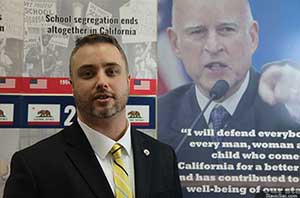The degree of patriotism seems so high here that even those who used to identify with Russians have now become lifetime enemies of the “Soviet Russia”.
“In America, in Western countries, the people are free,” says our guide, Chaplain Albert. “Why must we remain hostages of the Soviet slave mentality?”
Albert, like many other Ukrainians, learned the words of his country’s anthem at the Maidan, and now he volunteers for the army fighting in Eastern Ukraine. He keeps the soldiers’ spirits up and brings them food and water.
In the Ukrainian Army headquarters
After meeting the soldiers, we go to the so-called headquarters of the Ukrainian Army. There is a US-made Hummer, an old Soviet MAZ truck and a few other vehicles parked at the camouflaged high-rise building.
The soldiers are sawing and splitting wood to keep themselves warm during the cold winter nights.
The fighting spirit of the mixed Ukrainian army is very strong. It is constantly fueled by support of the locals. Instead of moldy Soviet military rations, frontline soldiers eat homemade preserves, fresh meat and other food delivered by volunteers. This is probably the only thing, besides the will to win, abundant in the Ukrainian Army.
The soldiers have their families, their children and their homes behind them. They say they have no place to run.
The thuds of mortar shells are heard from somewhere not too far away. I feel a bit uneasy and instinctively try to stay closer to the soldiers.
When we leave the improvised headquarters, we are accompanied by lady snipers who came out to warm up in the bright March sun.
What is this war fought over?
Definitely not the Russian language; at least not the Russian language alone. This is what I’ve been told by all the people I have met in Eastern, Central and Western Ukraine. Trust me, in the past 5 years I have crossed the country three times from Lvov to Mariupol. I visited Lutsk, Kiev, Donetsk, Slavyansk and many other places. And nowhere, I repeat, nowhere was I called a “Moskal” or any other slur word, despite the fact I only spoke Russian.
One of my friends from Lutsk does not exactly agree with me. He believes that Kiev should not have forcefully “Ukrainianized” the Eastern part of the country. According to him, it significantly accelerated and escalated the conflict between the two parts of the divided nation.
No matter what the Russian TV anchors tell you, the criminal actions of the “cynical Bandera supporters”, as President Poroshenko calls them, are not the reason for this war either. On the contrary, many refugees from the East are surprised by the unexpected welcome they receive when they come to Western parts of the country.

VIDEO: Embassy of California opens in Moscow
If you are one of the people who has watched too much of the depressing Russian propaganda, and you believe in the bands of Stepan Bandera’s followers roaming wild in the forests of Galicia, I recommend you buy a ticket and visit some place in Western Ukraine. I’m sure this fascinating journey will make you change your mind.
In my humble opinion, today’s Ukraine is a hostage of the geopolitical competition between the East and the West, between the US/EU on one side, and Russia on the other side. I totally agree with Pastor Gennadiy Mokhnenko that Western (and Central) Ukraine is growing away from Soviet mentality and leaving the Russia’s protectorate for good. You can definitely see it in the mood of Ukrainian people. They greet America and Americans much warmer than they do Russians.
NATO is fighting on Ukraine’s side
During my travel in Eastern Ukraine, news came from Odessa that some military aid from the West had arrived in that Black Sea port – namely, a few discarded border patrol ships from NATO countries. As usual, the Russian media has told the entire world about yet another shipment of military aid. In response, the Russian army in the Rostov region began sending in modern tanks and other military equipment.
Using the information from Russian TV channels, I tried to find any signs of NATO military aid. But no matter how I tried, I could not spot any significant quantities of Western armaments apart from two or three Hummers from the Gulf War period. Here and there you could see NATO helmets sent by private donors from Europe and US. No instructors, no German tanks, just boots and bandages – this is all the non-lethal help from volunteers abroad. Plus, maybe, bottles of Coca Cola and other food products that Mokhnenko and his team of chaplains supply to the soldiers.
“Unfortunately, NATO soldiers are not risking their lives for our families,” Mokhnenko commented on the common myth about Western support of Ukraine. “Our guys have to do it. They do not fight for the corrupt administration; they have their homes and their families behind them that no one else is going to save from the godless hordes.”
Ukraine’s armaments make you want to cry
I would like to note that, compared to modern Russian weaponry, the Ukrainian Army is impossible to look upon without tears.
If Kiev had any professional propagandists, they could destroy the enemy in one second. All they would have to do is publish some actual pictures of the Ukrainian soldiers’ equipment, and all the Russians would die laughing before even making it to the front lines.



